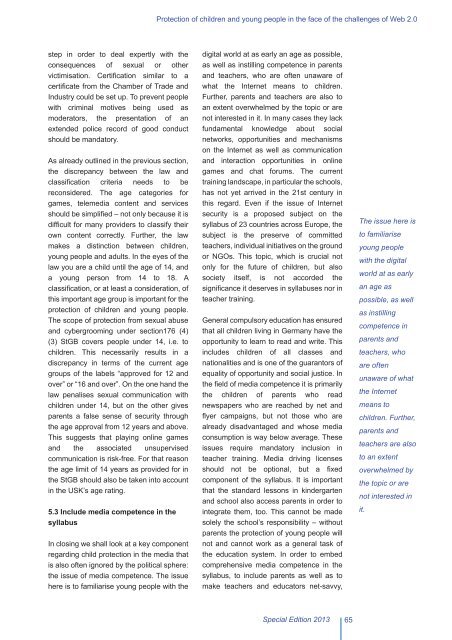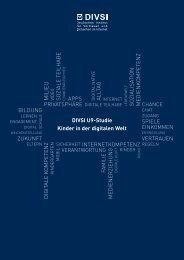ora-schriften-s-2013
ora-schriften-s-2013
ora-schriften-s-2013
You also want an ePaper? Increase the reach of your titles
YUMPU automatically turns print PDFs into web optimized ePapers that Google loves.
Protection of children and young people in the face of the challenges of Web 2.0<br />
step in order to deal expertly with the<br />
consequences of sexual or other<br />
victimisation. Certification similar to a<br />
certificate from the Chamber of Trade and<br />
Industry could be set up. To prevent people<br />
with criminal motives being used as<br />
moderators, the presentation of an<br />
extended police record of good conduct<br />
should be mandatory.<br />
As already outlined in the previous section,<br />
the discrepancy between the law and<br />
classification criteria needs to be<br />
reconsidered. The age categories for<br />
games, telemedia content and services<br />
should be simplified – not only because it is<br />
difficult for many providers to classify their<br />
own content correctly. Further, the law<br />
makes a distinction between children,<br />
young people and adults. In the eyes of the<br />
law you are a child until the age of 14, and<br />
a young person from 14 to 18. A<br />
classification, or at least a consideration, of<br />
this important age group is important for the<br />
protection of children and young people.<br />
The scope of protection from sexual abuse<br />
and cybergrooming under section176 (4)<br />
(3) StGB covers people under 14, i.e. to<br />
children. This necessarily results in a<br />
discrepancy in terms of the current age<br />
groups of the labels “approved for 12 and<br />
over” or “16 and over”. On the one hand the<br />
law penalises sexual communication with<br />
children under 14, but on the other gives<br />
parents a false sense of security through<br />
the age approval from 12 years and above.<br />
This suggests that playing online games<br />
and the associated unsupervised<br />
communication is risk-free. For that reason<br />
the age limit of 14 years as provided for in<br />
the StGB should also be taken into account<br />
in the USK’s age rating.<br />
5.3 Include media competence in the<br />
syllabus<br />
In closing we shall look at a key component<br />
regarding child protection in the media that<br />
is also often ignored by the political sphere:<br />
the issue of media competence. The issue<br />
here is to familiarise young people with the<br />
digital world at as early an age as possible,<br />
as well as instilling competence in parents<br />
and teachers, who are often unaware of<br />
what the Internet means to children.<br />
Further, parents and teachers are also to<br />
an extent overwhelmed by the topic or are<br />
not interested in it. In many cases they lack<br />
fundamental knowledge about social<br />
networks, opportunities and mechanisms<br />
on the Internet as well as communication<br />
and interaction opportunities in online<br />
games and chat forums. The current<br />
training landscape, in particular the schools,<br />
has not yet arrived in the 21st century in<br />
this regard. Even if the issue of Internet<br />
security is a proposed subject on the<br />
syllabus of 23 countries across Europe, the<br />
subject is the preserve of committed<br />
teachers, individual initiatives on the ground<br />
or NGOs. This topic, which is crucial not<br />
only for the future of children, but also<br />
society itself, is not accorded the<br />
significance it deserves in syllabuses nor in<br />
teacher training.<br />
General compulsory education has ensured<br />
that all children living in Germany have the<br />
opportunity to learn to read and write. This<br />
includes children of all classes and<br />
nationalities and is one of the guarantors of<br />
equality of opportunity and social justice. In<br />
the field of media competence it is primarily<br />
the children of parents who read<br />
newspapers who are reached by net and<br />
flyer campaigns, but not those who are<br />
already disadvantaged and whose media<br />
consumption is way below average. These<br />
issues require mandatory inclusion in<br />
teacher training. Media driving licenses<br />
should not be optional, but a fixed<br />
component of the syllabus. It is important<br />
that the standard lessons in kindergarten<br />
and school also access parents in order to<br />
integrate them, too. This cannot be made<br />
solely the school’s responsibility – without<br />
parents the protection of young people will<br />
not and cannot work as a general task of<br />
the education system. In order to embed<br />
comprehensive media competence in the<br />
syllabus, to include parents as well as to<br />
make teachers and educators net-savvy,<br />
The issue here is<br />
to familiarise<br />
young people<br />
with the digital<br />
world at as early<br />
an age as<br />
possible, as well<br />
as instilling<br />
competence in<br />
parents and<br />
teachers, who<br />
are often<br />
unaware of what<br />
the Internet<br />
means to<br />
children. Further,<br />
parents and<br />
teachers are also<br />
to an extent<br />
overwhelmed by<br />
the topic or are<br />
not interested in<br />
it.<br />
Special Edition <strong>2013</strong><br />
65





